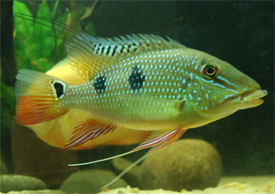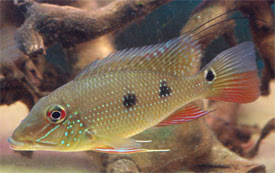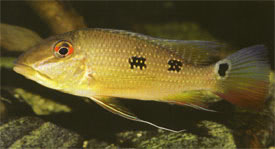
 Magyarul / Hungarian
Magyarul / Hungarian



- Scientific name: Satanoperca daemon
- Synonyms: Geophagus daemon
- Common name: Three Spotted Eartheater
- Group: Cichlids
- Habitat: South America; Venezuela, Colombia and Brazil
- Size: 25-30 cm
- Biotope: Inhabits in the Rio Orinoco basin and in the upper Rio Negro, in slow-flowing, tea-colored, calm waters along wooded shorelines with sandy, muddy or loamy bottoms.
- Social behavior: Territorial, quite peaceful cichlid. If only Satanoperca daemon are kept in the tank, the dominant male will chase the other fish quite regularly, so they sould be kept with other similar sized eartheater species.
- Diet: Omnivorous; They will eat almost any live and frozen foods, however they require a great amount of vegetable matter, like spirulina alage.
- Breeding: Hard
- Tank: Minimum 250 litres
- Population: 5-6 fish for 600 litres
- Decoration: They require a very fine/soft substrate in which to search for edible matter. A few hiding places in the form of roots/wood, or a layer of various floating plants to provide shade, will be beneficial to the well-being of the fish.
- Temperature: 28-32 °C
- pH: 3.2-6
- Hardness: 1-4 NK°
- Lifespan: 5-8 years
Description: The body base color is green-olive, while the back and the ventral region appear rather darker than the rest of the body. Depending on mood a number of cross-bands may appear on the forehead, and there may be two parallel longitudinal lines running from the mouth in the direction of the eye. The three lateral spots, which are present even in juveniles, are an unmistakeable character of this species. While two of these spots lie on the body, the third is on the upper edge of the caudal fin base and is bounded by a light bluish-white ring. On Satanoperca daemon the last five rays of the soft dorsal are produced to magnificent black filamentous trailers that hang back past the caudal fin. On wild caught species the ventral and the anal, as well as the lower half of the caudal fins are also red, or at least orange, in many populations. Juveniles are greenish and exhibit rows of iridescent bluish dots on the flanks. Satanoperca daemon is noted as being susceptible to hole in the head disease, so providing a balanced, varied diet is absolutely vital to the wellbeing of this fish. Satanoperca daemon is very much a warmth-loving cichlid which should not be kept at temperatures of less than 26 °C, as they lose their appetite, and became inactive. They originate from blackwater conditions, which are soft, and acid waters, so in the aquarium these parameters should be replicated. Also characteristic of these habitats are dissolved tannins that give rise to the dark, tea-colored tint of such waters, which can be replicated peat moss, bog wood, and oak leaves.
There are various rumours about the dimorphism of Satanoperca daemon, like the dorsal fin of mature male daemon can differ to that of the mature female, but there is no evidence to support this. Three Spotted Eartheaters generally referred to as exhibiting no sexual dimorphism, however the sexes can be differentated only on the basis of eventual size, as females remain a few centimeters smaller than males. Breeding is very hard, and unique. During coutship both parents dig spawning pits together, in which the female lay her 1 mm, adhesive, light grey eggs in batches of 15-20 at a time. After each egg-laying pass the male glide over the eggs and fertilise them. The spawning can last for an hour, and the number of the eggs can be 200. After spawning the eggs are covered with a 3-5 cm layer of sand. This type of behavior has not been observed in any other Satanoperca cichlid. If the pair don't use sand to cover the eggs, they will sometimes consider using small pieces of wood or stones from the aquarium's decor. The female tend the spawn, fanning fresh water with her pectoral fins, while the male guards the territory. The eggs will stay covered for several days before tiny wrigglers can be seen being moved by the parents to another pit. The wrigglers will then be covered again. After a total of six days the fry free themselves from the heap of sand without parental assistance and hover over the sandy bottom. Juvenile daemon are extremely sensitive to both pollutants and stress. It is recommended that partial water changes take place every 3 or 4 days for around the first month.



